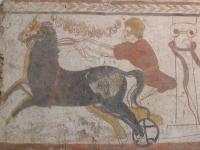Search results
-

-
Title
-
Fresco with Funeral Games
-
Abstract
-
The five images in this series are from the south and north long walls of the same cist tomb, Tomb X of the Laghetto necropolis. They depict funerary games that were part of the rituals surrounding the burial of an elite man or woman in 4th century BCE Lucanian society.
-
Date
-
4th c. BCE
-

-
Title
-
Circus Maximus
-
Abstract
-
View of the remains of the Circus Maximus today.
-
Date
-
Europe--Italy--Rome, 6th c. BCE-5th c. BCE-4th c. BCE-3rd c. BCE-2nd c. BCE-1st c. BCE-1st c. CE-2nd c. CE-3rd c. CE-4th c. CE-5th c. CE
-

-
Title
-
Circus Maximus (Scale Model)
-
Abstract
-
The scale model of imperial Rome was made under the direction of I. Gismondi for the Museo di Civiltà Romana (1933-1955). This section represents of the Circus Maximus in its urban context. Of especial note is its collocation of the circus with the imperial palaces on the Palatine Hill to the left; the imperial box (pulvinar) is clearly shown. The model shows the monumental starting gate structure at the upper (west) short end of the circus, as well as the arch at the east end. The central barrier around which the chariots raced (spina) is decorated with various monuments including the turning posts (meta) at each end, obelisks, shrines an statues.
-
Date
-
6th c. BCE
-

-
Title
-
Mosaic with Circus Scene
-
Abstract
-
The mosaic represents a chariot in the circus, with spectators (heads only represented) watching, in a rather naive style with squat stylised figures. This complex scene is presented from a ‘bird’s eye view, with the spina represented running down the race track. The spina is decorated with several obelisks. The artist has made an effort to represent lions within the structure of the spina, which may be a reference to the complexity of games held in the circus, that also included venationes (animal hunts). To the right are the carceres (starting gate) with four arched openings within which are nude, running male figures, placed at awkward angles relative to the gates. Again, this may be a reference to athletic competitions included as part of games. There are four chariots racing, two each on either side of the spina. Well preserved are those above the spina, chariots of the Green and Blue factiones (factions). Various attendants, some at odd angles are also represented. Above the circus are spectators under arches, shown only as heads, or busts. Other structures are also pictured in the arena, like the temple in the top left.
-
Date
-
6th c. CE
-

-
Title
-
Krater with Chariots
-
Abstract
-
Black-figure terracotta krater depicting a charioteer in a quadriga on both the obverse and reverse. Inscriptions are found above the chariot and beside the horses legs.
-
Date
-
6th c. BCE
-

-
Title
-
Circus of Maxentius
-
Abstract
-
The Circus of Maxentius is much better preserved than the Circus Maximus. In evidence are the restored remains of the long central barrier (296 meters) around which the chariots raced (spina) and at each of its ends, and the restored substructures for the turning posts (metae). The remains of the vaulted substructures (north and south sides) on which were constructed seats for approximately 10,000 spectators are preserved on each of the long sides, as is the short eastern wall. The Circus of Maxentius is part of a larger complex which includes an imperial villa palace to the north west of the circus and connected to it by a hallway leading to an imperial viewing box (pulvinar); and a mausoleum for Romulus, the son of Maxentius.
-
Date
-
Europe--Italy--Rome, 4th c. CE